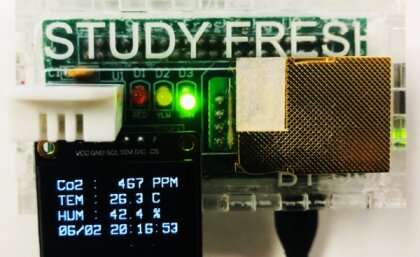Carbon dioxide sensors could be beneficial in classrooms. Credit: Study Fresh Project
Ensuring school classrooms are well ventilated is key to reducing the risk of COVID-19 transmission and maintaining academic performance, research from The University of Queensland has revealed.
UQ's Study Fresh project team, led by Dr. Stephen Snow, placed carbon dioxide sensors (CO2) in 67 classrooms across primary and secondary schools in Greater Brisbane throughout 2021.
Dr. Snow said 42 classrooms recorded CO2 concentrations above 1800 parts per million (ppm)—a concentration which poses an elevated risk of COVID transmission and may negatively affect some aspects of student performance.
"Concerningly, CO2 concentrations in 16 classrooms remained above 1800 ppm for more than three hours on one or more occasions," Dr. Snow said.
Carbon dioxide is exhaled by humans and will quickly accumulate in poorly ventilated spaces, so measuring the quantity of CO2 provides a good estimate of the air quality in occupied rooms.
According to OzSAGE, an independent Australian scientific body, CO2 readings above 1500 ppm indicates a high risk of COVID infection.
Studies have also shown that aspects of cognitive performance may be temporarily affected by sustained exposure to concentrations over 1800 ppm.
Dr. Snow said being aware of the need to introduce fresh air into classrooms was of critical importance as children remain at school amid the pandemic.
"It is easy for classroom CO2 concentrations to exceed the risk thresholds for COVID transmission, because we usually don't realize air quality is declining, and most classrooms don't have CO2 monitors," Dr. Snow said.
Dr. Snow said the key to improving air quality in classrooms was a simple one—opening windows, where possible, to encourage the intake of fresh air.
"Many older school classrooms have had air conditioning installed, which is fantastic for Queensland's hot climate, but not all introduce fresh air," Dr. Snow said.
"If the air conditioning is off, keep windows open, so you've got a constant supply of fresh air, and if you can, open windows on two or more sides of the room to create flow-through.
"If you do need the air conditioner on, close the windows while it's running so the room can cool down, but consider opening doors and windows in between lessons or during lunch, to replace the air in the room."
Dr. Snow also suggests the use of CO2 monitors in classrooms, so air quality can be monitored.
"We need to be really conscious of how much we're ventilating classrooms," Dr. Snow said.
"As part of our Study Fresh project, we actively collaborate with schools and engage the students as citizen scientists to build and program their own CO2 sensor prototype and measure their classroom's air quality."
"By being involved in this project, students get to contribute to meaningful research, engage with scientists, and increase their science literacy by asking critical questions," he added.
Study Fresh is an initiative of UQ involving researchers from the Schools of Information Technology and Electrical Engineering and Architecture.
The research has been published in the journal Frontiers in Computer Science.
More information: Stephen Snow et al, Human factors affecting ventilation in Australian classrooms during the COVID-19 pandemic: Toward insourcing occupants' proficiency in ventilation management, Frontiers in Computer Science (2022). DOI: 10.3389/fcomp.2022.888688
Provided by University of Queensland
























